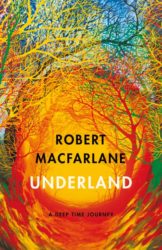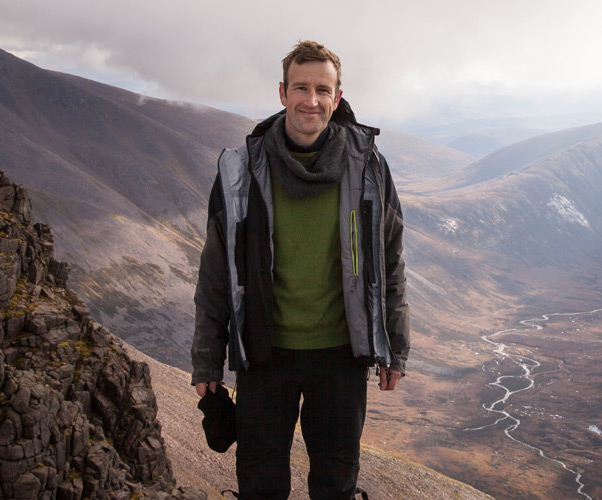Book Review: “Underland: A Deep Time Journey” — Between Despair and Hope
By Steve Provizer
Robert Macfarlane’s ability to limn the pull between beauty and cataclysm provides a dynamism that elevates this book well above the level of simple “nature” writing.
Underland: A Deep Time Journey by Robert Macfarlane. W.W. Norton, 496 pages, $16.14.

Robert Macfarlane and I share the same schizophrenic perspective on the prospects of life on this planet. We both toggle between ecological despair and a sense that shit’s too good to just go away. The difference between us is that he has the guts to risk his life in exploring this dichotomy and the skills to write a probing, fascinating book about it.
Although it’s reductionist to call Macfarlane simply a “nature” writer, that’s the fulcrum for most of his books: Mountains of the Mind (the allure of high places), The Old Ways (remaining wildness in Great Britain), Landmarks (the language of landscape). In Underland, he goes down. He caves in England, Italy, Slovenia, Norway, and Finland; he explores the catacombs of Paris and the (rapidly diminishing) ice of Greenland.
In each setting, Macfarlane is abetted by locals who have deep knowledge of the terrain and he takes the time to limn their looks and character for the reader. He is a skillful observer of people, but it’s his ability to describe the terrain, plants, birds, and animals of widely divergent ecosystems that is truly impressive. The most satisfying example of his perceptive descriptive fusion of humans and nature is his re-imagining of the process of the prehistoric cave painters who worked at Lofotens, Norway:
Here in the shadows, space and time spill into one another. If life exists, it is the slow life of rock, it is the sea’s patient exploration of the mountain’s inside.
Up where the tunnel wall overhangs them, the figures halt, make their preparations. Rock is to be the painter of rock. In a cup of stone they crush hematite and mix it with spit, earth, and rainwater to make a red paste.
The painting begins.
Indeed, there is much artful writing in this book: Nature is “an assemblage of entanglements of which we are messily part.” “My clumsy bag of bones and blood.” “The ice seems a ‘thing’ that is beyond our comprehension to know but within our capacity to destroy.” I enjoyed this kind of descriptive prose more than his specific attempts at poesy, which are sometimes signaled in an over-determined way, by the exclusion of articles (the, an). However, that’s a minor quibble because the language generally flows beautifully, both in his depictions of rock, sea, or ice and in his narrations of spelunking, climbing, and other explorations. Despite the fact that we know he will survive the hardships and dangers, his tales of adventure are riveting.
The tension between the natural splendor of a scene and the ravages of man I mentioned at the beginning of this review plays out throughout the book. Even in the most isolated, seemingly pristine environments that Macfarlane explores, he sees plastic effluvia, the traces of civilized man. He spends time exploring spaces beneath the Slovenian Alps — the scene of human carnage for a century. Here he expresses one variable of the tension: “Dissonance is produced by any landscape that enchants in the present, but has been a site of violence in the past. But to read a place only for its dark histories is to disallow its possibilities for future life, to deny reparation or hope — and this is another kind of oppression.”

Author Robert Macfarlane. Photo: Walk Magazine.
Two chapters lack this tension between destruction and hope because they are pessimistic in the extreme. One chapter deals with the underland cavern the Finns are constructing in order to store the waste from their nuclear plants. Macfarlane’s attitude is symbolically made clear when he describes the animatronic model of Einstein on display in the visitor’s center:
Einstein’s upper body lurches toward us and stops with a jerk that dislodges the right-hand half of his grey moustache, which droops slowly forward over his upper lip. A recorded voice that I do not take to be Einstein’s begins to speak to us in Finnish.
The chapter about Greenland is uniformly pessimistic. How could it be otherwise? The locals who are guiding his forays describe the incessantly retreating line of ice and the disappearance of glaciers. Macfarlane describes how rising temperatures and melting permafrost around the world exposes biological, chemical, and nuclear waste sites, encourages the proliferation of mosquitoes, and inspires the depression that takes hold in the people who live in environments that are being destroyed (called “solastalgia”).
And yet, Macfarlane writes about ice as a man who is truly moved by its subtleties and the capacity of ice cores to reveal secrets about the planet. As he writes: “The color of deep ice is blue, a blue unlike any other in the world—the blue of time. . . . The blue of time is so beautiful that it pulls body and mind towards it.”
Macfarlane’s ability to limn this pull between beauty and cataclysm provides a dynamism that elevates this book well above the level of simple “nature” writing. Examining the complex interactions between the vitality of our planet and the predations and glories of mankind is no easy task. I’ve never seen it done as well as it is in Underland.
Steve Provizer writes on a range of subject, most often the arts. He is a musician and blogs about jazz here.
